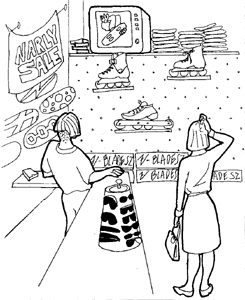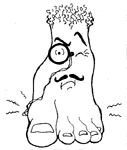Rentals
Anyone unsure about adding in-line skating as a new activity should rent a pair first. Unfortunately, with the passing of the boom, in-line skate rentals may be even harder to find than skate specialty shops. (Suggestions for San Francisco Bay Area residents.) If your local ski, bike or skateboard shops don’t pan out, try looking at the listings under “Skating” in the yellow pages. Be sure your rental skates come with a heel brake and that all protective gear is provided, including a helmet.

If you’re lucky, the rental fee can be applied towards the purchase of your own new pair of in-lines. If you don’t mind starting with used skates, ask when the rental line will go on sale. Some great deals can be found in the rental bins in late summer.
Once you’re rolling, it may take an hour or so before any feature of a skate boot starts to bother you. If at all possible, try renting different models, either on the same day or over several days.
Don’t be a cheapskate
Too often, the main priority of first-time buyers is to spend as little money as possible, which invariably leads to a disappointing introduction to the sport. See Advice Well Taken for one reader's direct experience with this.
In-line skates are not toys and should not be purchased at a toy store. Go to a sporting-goods store where you can find a wider selection and qualified sales staff to answer your questions and make suggestions.
Low-end skates are built of low-quality materials, usually resulting in foot pain, little or no ankle support, sluggish bearings and a rough ride. With such distractions, it’s almost impossible just to learn how to stop and go. Cheap skates are more likely to break, too. Broken buckles or detached wheels are extremely dangerous when they occur at a roll.
Unlike higher-quality skates, cheaper models often can’t be upgraded with new brakes, better wheels, or faster bearings. Their unwitting new owners, discouraged when they just can’t seem to keep up with other skaters or get the hang of the basics, think it’s their own lack of skill that’s the problem. Those who persevere end up spending more money on upgrades or on new, better-quality skates.
Getting a good deal
I respect the very normal desire to save money when you don't know for sure if this sport is for you. But remember, foot pain seems to be inversly proportional to skate cost. Here are your best money-saving tips:
- Shop at my Skating Store to find good deals on brands I recommend, available at Amazon.com.
- Skate technology doesn't change much from year to year so look for last year's skates, which are sure to be on sale for at least 40% off the list price. You might even take home a $200 pair of skates for half that price.
- Invest as much as you can afford. For adults, a pair of skates with an original list price of less than $150 will cost more money than a better pair in the long run. Sometimes an extra $10 determines whether or not you will be able to upgrade a skate’s components later on.
- Shop around. Make it a point to visit a couple of retail shops or call around to compare selling prices for the skates you like. With a bit of legwork, you can make sure you’re getting the best deal.
- After you try on several skate models and several shops, you should know which is the best for you in your price range. That's the point where you might consider entering a search for them on the Internet to see if there are better deals.
Getting the right skates and fit
Here are some practical tips for outfitting yourself or your kids:
- If you’re shopping for a child, purchase a skate model that can be adjusted to accommodate multiple sizes. These are made by the top manufacturers, and retail for under $100.
- Novices and large people need a skate with superior ankle support. Look for a high, molded-plastic cuff and at least one buckle at the top. Unless you’re sure you’ll be moving on to play in-line hockey, don’t start out with laces-only skates, which tend to loosen up and lead to wobbly ankles.
- Check with sales staff to make sure replacement wheels, bearings, and especially brakes are available for the skate you choose.
- When trying on skates, wear a pair of absorbent socks you plan to skate in, but not too thick because they might bunch up or cause a sloppy fit. Socks manufactured specifically for athletic activity are best because they are designed to "wick" the sweat away from your foot and prevent blisters.
- Consider purchasing a skate with cuff-activated braking technology (such as Rollerblade, Inc.’s ABT). This feature is a godsend to the sport because beginners aren’t required to balance on one foot in order to stop: all eight wheels remain on the ground and the brake is much easier to engage.
- Don’t start out with five-wheel skates. They are much more expensive, more difficult to turn, and built for speed.
- Ladies’ skate models are available from the better manufacturers. They usually compensate for the lower position of a woman’s calf muscle and her narrower Achilles tendon. If the tag doesn’t differentiate genders, the skate is unisex.
Recreational skate features
Cuff-activated brakes: It’s hard to relax and enjoy liberated in-lining until you’re sure of your ability to stop. The introduction of cuff-activated braking technology in 1994 made stopping much easier for beginners, letting them tackle other basic skills with more confidence. These brakes use an arm-like mechanism mounted on the back of one skate’s cuff. As the cuff flexes backward in response to pressure from your calf as you push the brake foot forward, it forces the brake downward until it begins to drag on the pavement. Don't let friends or shop personnel talk you out of purchasing a skate model with this wonderful beginner's asset!
Contrary to what some well-intentioned advisors say (most of whom have never learned how to make any kind of heel brake work), cuff-activated brakes are effective and useful for all skill levels. Because you can lower the brake pad as it wears down, or raise it as your braking skills improve, it’s also appreciated by more experienced skaters. Finally, slalom enthusiasts can easily engage cuff-activated brakes for mid-carve speed control without interrupting their rhythm when skating downhill.
Soft vs. plastic: In the interests of light-weight breathability and comfort, several manufacturers offer a suede-and-mesh combination boot. In some models, the snug but cushy fit may mean slightly less support (though most are equipped with an exterior plastic cuff), but for extended sessions may remain comfortable. I've noticed that if there isn't enough rigid plastic in back, some soft boot skates make it harder to brake effectively.
Vents: Look for vents in the boot and liners in both plastic and soft boot skates. Breathability slows down the buildup of perspiration as your feet heat up. Being lightweight makes any skate more maneuverable and less tiring over long periods. Vents improve airflow and help reduce the weight, too.
Hinged cuffs: Hinged cuffs improve a skate’s ankle support, forward flexibility, and stability. Many soft boot models are outfitted with a plastic hinged cuff for added support. Some forward flex stiffness is good; too much flexibility gives you less ankle support and control.
Buckles: In-line skates are manufactured with every possible combination of buckles and laces. A top buckle delivers solid ankle support. All-buckle models are easier to get on and off your feet. Laces allow a more custom fit for better performance.
Liners: The foam-padded liners inside plastic in-line boots are replaceable but they're hard to find and cost about half as much as a new pair of skates does.

Sizing: Men’s, women’s, and junior models are usually available in a good manufacturer’s skate line. Some women may find a great fit in a small men’s boot (using either the men’s or women’s boot liner), and men with narrow feet have been known to fit comfortably into women’s skates.
Insoles: All good-quality skates feature a removable pre-formed arch support. In higher-priced models, these may come with customizing attachments. Some skaters insert their own arch supports to fine-tune the boot’s fit for maximum responsiveness.
Frames: Wheel frames accommodating three wheels are designed for smaller feet, four-wheel frames are best for recreational, hockey, and artistic skating, and five wheelers are built for stability at high speeds and powerful strides. At the specialty end, frames can be equipped with "grind plates" to facilitate rail and curb grinding, or made from strong, light weight composites for speedskaters.
Wheels: A new skate’s wheels feature the core type, hardness, profile and diameter deemed to be best suited to the features of the skate on which they are mounted. For such a small product, there is a relatively large amount of terminology, technology and hype to be assimilated before you can become an informed buyer. Before you shop, be sure you know the maximum wheel size your skate’s frames can accommodate (found in the owner’s manual).
How in-line skates should feel
All feet are not created equal. Buying skates is like buying ski boots. They may seem comfortable to stand in, but an hour of vigorous activity may lead to the painful realization that the shell of that particular boot was not designed for your particular foot. When checking for fit, try to keep the skates on at least 15 minutes to give them a chance to hurt. Run through the following checklist of good fit requirements. You should be satisfied in every area.
- The boot tongue is not digging into your shin or calf.
- There is no pressure on the widest part of your foot due to a narrow fit.
- There is no crease-type pressure across the tops of the toes when you flex your knees to sink lower.
- There is no specific pressure point across the top of the arch of either foot.
- The overall fit is very snug, but you can wiggle your toes.
- With straight knees, your toes lightly touch the end of the boot.
- When you bend your knees and press your shin into the tongue (this is normal skating stance), your toes are not touching the end of the boot and your heel does not slide up and away from the sole.
So, please, when buying new skates - especially that all-important first pair - don't be a cheapskate! Give yourself or your child a fair chance to enjoy the sport of in-line skating.
See a list of recommended manufacturers' web sites and phone numbers in the Gear section of our Resources page. For more biased advice, see Why I Recommend Rollerblade, K2 and Salomon Skates. -- Liz